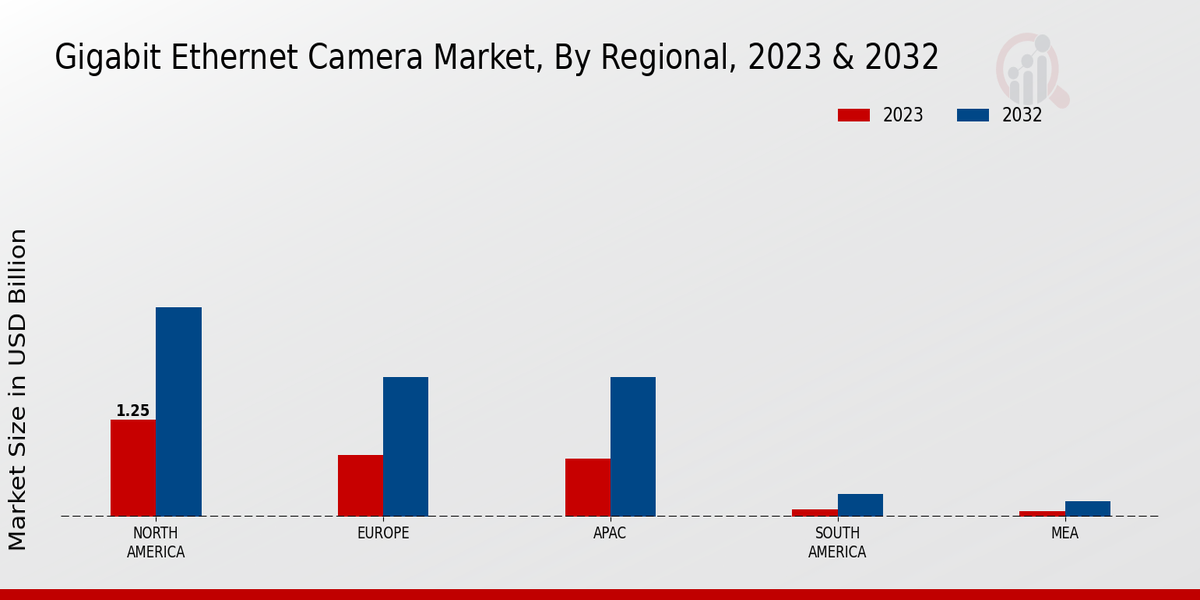Growing Security Concerns
Growing security concerns across various sectors are driving the Global Gigabit Ethernet Camera Market Industry. Organizations are increasingly aware of the need for robust surveillance systems to protect assets, personnel, and sensitive information. This heightened awareness leads to increased investments in high-quality camera systems that can provide reliable monitoring and deterrence against criminal activities. The rise in incidents of theft, vandalism, and cyber threats further emphasizes the necessity for advanced surveillance solutions. As a result, the market is expected to witness a compound annual growth rate of 9.16% from 2025 to 2035, reflecting the urgent demand for enhanced security measures.
Market Growth Projections
The Global Gigabit Ethernet Camera Market Industry is poised for substantial growth in the coming years, with projections indicating a market value of 3.54 USD Billion in 2024 and a potential increase to 9.28 USD Billion by 2035. This growth trajectory suggests a compound annual growth rate of 9.16% from 2025 to 2035. Such figures reflect the increasing adoption of Gigabit Ethernet cameras across various sectors, driven by technological advancements and rising security concerns. The market's expansion is likely to be influenced by the ongoing integration of smart technologies and the demand for high-resolution imaging solutions.
Expansion of Industrial Automation
The expansion of industrial automation is a key driver of the Global Gigabit Ethernet Camera Market Industry. As industries increasingly adopt automated processes, the need for high-quality imaging systems becomes essential for monitoring production lines, quality control, and safety compliance. Gigabit Ethernet cameras provide the necessary resolution and speed to capture critical data in real-time, facilitating efficient operations. Industries such as manufacturing and logistics are particularly benefiting from these advancements, as they rely on precise monitoring to optimize performance. This trend is expected to contribute to the market's growth, aligning with the overall shift towards automation in various sectors.
Increased Adoption in Smart Cities
The Global Gigabit Ethernet Camera Market Industry is significantly influenced by the increased adoption of smart city initiatives worldwide. Governments and municipalities are investing in advanced surveillance systems to enhance public safety, traffic management, and urban planning. Gigabit Ethernet cameras are integral to these initiatives, providing high-quality video feeds that facilitate real-time monitoring and data analysis. For example, cities implementing smart traffic management systems utilize these cameras to monitor traffic flow and reduce congestion. This trend is likely to propel the market forward, as the integration of smart technologies in urban environments continues to expand.
Rising Demand for High-Resolution Imaging
The Global Gigabit Ethernet Camera Market Industry experiences a notable increase in demand for high-resolution imaging solutions across various sectors, including surveillance, healthcare, and industrial automation. As organizations seek to enhance their operational efficiency and security measures, the need for cameras that can deliver superior image quality becomes paramount. For instance, in the surveillance sector, high-resolution cameras are essential for identifying individuals and monitoring activities in detail. This trend is expected to contribute significantly to the market's growth, with projections indicating a market value of 3.54 USD Billion in 2024, reflecting the increasing reliance on advanced imaging technologies.
Technological Advancements in Camera Systems
Technological advancements play a crucial role in driving the Global Gigabit Ethernet Camera Market Industry. Innovations such as improved sensor technology, enhanced image processing capabilities, and integration with artificial intelligence are transforming the functionality of Gigabit Ethernet cameras. These advancements enable features like real-time analytics, motion detection, and improved low-light performance, making these cameras more appealing to end-users. As a result, industries are increasingly adopting these sophisticated systems to meet their operational needs. The anticipated growth trajectory suggests that the market could reach 9.28 USD Billion by 2035, driven by continuous technological improvements and the demand for smarter surveillance solutions.






















